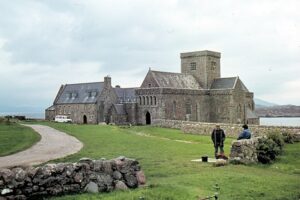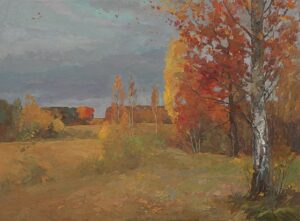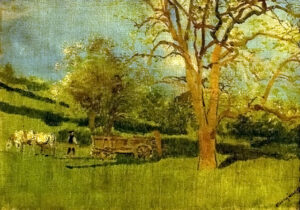The Sacred Celtic Views of Nature in “November Sunshine” by Hugo Laubach
© Copyright 2024 Lorenzo Gonzaga, Toronto Metropolitan University
The Views Regarding Nature in Celtic Culture

In regards to Celtic culture and beliefs, they belonged to the ancient people who lived in European regions such as Ireland, Scotland, Wales, and France. From this, they possessed a view of nature that entailed that all things natural, like plants and animals, were sacred and had significance. When it comes to these Celtic beliefs, they are evident on the island known as Iona, which is in Scotland (Béres).
Within Iona, a significant spiritual presence is held there. This can be attributed to the fact that the island has been around for centuries and has mostly remained unchanged. However, a major geological change over the years came from the changing climates, which allowed for sand to form and, in turn, allowed for the plants and flowers of the island to flourish. In regards to this, through Celtic culture, it can be assumed that changes in nature served as a way for it to communicate with people. Moreover, in terms of the appearance of the island, it is rugged and shaped by greenery and ancient rocks, which pre-existed any life form, thus resulting in no fossils to be found (Béres).
In light of Iona, it greatly showcases what made Celtic views regarding nature so sacred. It captures the interconnectedness of all things living and presents a divine essence. From the island’s flowers and greenery to the rocks untouched by time, every natural element of the island reflects deep importance.
Analysis of “November Sunshine” by Hugo Laubach

With the sacred views held by Celtic people, they are commonly depicted through art and literature. An example of this is Hugo Laubach’s poem “November Sunshine”, which can be found in a magazine called The Evergreen – Volume II, Autumn (1895). Although this line of magazines was created in the 19th century, it aimed to revive and celebrate Celtic heritage (Macdonald and Shaw 33). In particular, The Evergreen – Part II aimed to serve as a reconnection to nature, a celebration of identity, and an engagement with broad cultural and intellectual movements, according to the prefatory note of the magazine (Geddes).
In terms of Laubach’s poem, the emotion it conveys can be seen as depressing. In the opening stanza, it paints an image of a grim and dull November landscape, as the scene is set with phrases such as “misty plain” and “pale grey water”. As the poem progresses to the second stanza, Laubach introduces a figure described as a “wan woman” with “tear-dimmed eyes”. The use of the word “wan” further ties into the image of a grim and dull November landscape, as it means that the woman appears pale, maybe even ill (Laubach). The fact that she has tears in her eyes alludes to the fact that she was crying and further emphasizes the depressing emotion that the poem conveys.
In this stanza, this woman is described as seeking something beyond the shadows. While the thing she is seeking is never specified, this can allude to feelings of despair, as what she is seeking has no sense of direction. As the poem progresses onto the third and final stanza, the mood of despair is brought over with phrases like “Dead hope!” and “sigh that is spent in vain”. As the poem comes to an end, Laubach mentions the decline of autumn, as the bright sun sinks. In doing so, he also mentions how this decline of autumn makes the heart pale and lonely (Laubach).
Many writers from Scotland and Ireland during this time period were passionate about bringing back their cultures. Their styles of writing were done in a way that transparently showed their cultural identities and beliefs (Macdonald and Shaw 2). Given this, it can be assumed that Laubach had the goal of doing this in his poem. “November Sunshine” depicts a strong connection to nature as it reflects the beauty of the natural world through its word choices, imagery, and emotional depth.
In essence, “November Sunshine”, a touching but poignant perspective on sacred Celtic views, is provided in literary form. While on the surface of this poem, the Celtic views may seem more nuanced, Laubach’s word choices provide a deep delve into the emotional aspects of nature that Celtic people cherish, which in turn creates a profound connection to their cultural heritage.
How Acceptance of Change is shown in “November Sunshine”
To further expand on “November Sunshine”, the imagery and word choices that were used also depict the acceptance of change in nature. The poem captures the transitional period of sunshine and warmth to the chill landscape that November possesses. For instance, Laubach uses phrases like “pale grey water” and “roadways wet with November rain”, and this is able to contrast when he uses the phrase “beautiful november sunshine”. It is through this juxtaposition that Laubach reflects how the weather in November tends to clash. Within the month of November, the weather can sometimes appear gloomy, and sometimes it can appear sunny. This is due to the fact that November serves as a transitional period from warm autumn days to cold winter days.
With “November Sunshine” being able to capture this, it shows the inevitable fluctuations that occur in life and nature. In relation to what Celtic people believed, they had a perception of time and history as cyclical (Feehan 290). This is shown in the poem as it presents seasonal shifts, which underscores ideas of continuous change and cycle. This can connect to the initial point made about how, in Celtic culture, it can be assumed that changes in nature served as a way for it to communicate with people. Additionally, it shows that nature operates in a way where aspects need to co-exist in order to create balance.
Comparing “November Sunshine” and “A Carol of Youth”

When it comes to Hugo Laubach, he appears to be a poet who would typically feature his work in Patrick Geddes’ line of magazines known as The Evergreen. He has a poem titled “A Carol of Youth”, and this can be found in The Evergreen – Volume I, Spring (1895).
Regarding this poem, it is about the arrival of spring and the change of scenery after winter. Words such as “love”, “delight”, “carols”, and “song” are used in the opening stanza, and this gives the impression that the arrival of spring is being celebrated. In addition to this, phrases like “crown him with laurel” and “lips are of coral” are used in the second stanza. Through this, it uses imagery to depict the honour and beauty that come with spring. Concerning the entire poem, elements like this are presented all throughout.When comparing ‘November Sunshine’ and ‘A Carol of Youth’, there are many similarities and differences between the two poems.
In regards to the similarities, both “November Sunshine” and “A Carol of Youth” are both centred around seasonal themes. With these seasonal themes, they both also use vivid imagery. Through this vivid imagery, each poem creates a specific mood for the reader, and in turn, this creates an enhanced reading experience. It allows readers to feel immersed in the settings of nature depicted by Laubach. Furthermore, they both focus on the cyclical nature of seasons changing and highlight how specific weather can create a specific mood for a person. Lastly, for both poems, Laubach implemented a rhyme scheme that creates harmony and cohesion.
As for the differences, the most evident one is seasonal focus. Like mentioned before, “November Sunshine” is focused on colder seasons like autumn and winter, while “A Carol of Youth” is focused on warmer seasons like spring and summer. With each poem having a focus on specific seasons, differences can also be seen in the imagery and tone. “November Sunshine” possesses imagery and word choices that are more sombre, while the ones in “A Carol of Youth” are more joyful. From this, it can be assumed that Laubach thought each season carries its own emotion and significance. On top of this, “November Sunshine” has a strong focus in regards to reflecting on the past, while “A Carol of Youth” has a strong focus on looking forward and embracing the present. To finish off, while both poems use rhyme schemes, the one used in “November Sunshine” was more complex as it used longer words and more intricate patterns. On the other hand, the rhyme scheme used in “A Carol of Youth” used shorter words and was a lot more straightforward, mirroring the joyful emotion.
With all things considered, it can be seen that Laubach had a specific style when it came to writing his poetry. He had the tendency to use seasons as the focus, emotional depth, and vivid imagery in order to create immersive pieces. However, judging by the difference shown in the two poems, it shows that Laubach was also a very versatile poet, as he was able to create pieces reflecting both sadness and happiness in their own unique ways.
Conclusion
All in all, it can be seen through Hugo Laubach’s poem “November Sunshine” that the Celtic people of European regions such as Ireland, Scotland, Wales, and France possessed very sacred views regarding nature. However, the poem does more than just show readers how Celtic people perceived nature. With this poem, a beautiful perspective on nature is provided and goes way beyond the surface of what is expected from colder seasons like autumn and winter.
Works Cited
Béres, Laura. “How travel might become more like spiritual pilgrimage: An autoethnographic study.” Journal for the Study of Spirituality, vol. 8, no. 2, 2018, pp. 160–172, https://doi.org/10.1080/20440243.2018.1523048.
Feehan, Ellen. “Frank Herbert and the Making of Myths: Irish History, Celtic Mythology, and IRA Ideology in ‘The White Plague’ (Frank Herbert et la création mythique: histoire irlandaise, mythologie celtique, et idéologie de l’Armée de Libération Irlandaise).” Science-Fiction Studies, vol. 19, no. 3, 1992, pp. 289–310, https://torontomu.summon.serialssolutions.com/2.0.0/link/0/eLvHCXMwhV1NT9wwEB0VLuUC_QC6haIRqkor7bYkcWKHG0IgkBa1QnCOHHvSrrQNaHc57E_a37H_qefaEwfEAuIWxYmdj6fx88z4DUASf9_vLdgEqcvUyEzkia6yKrMOJ6IyNk-IVCZttbCt-3O7NcZnWXKaIAf1HV8qh_RDuFkokmoJlpQIZcvvszoS1TDePArEcSGc3OYdPrK9PKGcrMHPduw2k8T7FIKcwN8n9Bpfesw3sBq4JR42YHgLr6h-B5v94JEc4xfs34koj9_DPy7Yjqfuw9Jogrq26NggnnN9Kryu8Hw6-TM-QC5Cj42eyLSLR-QFO7iRXfJdvvPs4hDPLJcJnuKgxl2HP-Tqe_hrqH_f0i5-fTgeTXCo0YzmMwYHei-rF5M9QNZAdqYYB7wT2Qe3utzMhprQ-CdwV3Z9HwM7n4XzlnC455A7n_Fxf1DOZw3A3Tu0PX1bh6uT48uj014oA9Ezbr2a9uIyIZukmTBuBV2SY3hkHIuMtYwiK6qUOUZmhI7y1BpnoSpptYwVGV36oGSyAcv1dU0fAEVpbJpalZXSCiGFVt6Rq3KKyUeUZQd2HqKl0D78U1zse50_xxQ7sM7_ubhptECK8JM7sN2iqQhGYFxEvi6YknkcdWDrcXMce11mlacfn-l0C1Y4OZh3Pm7D8mR0S5_g9R0Wdxj6_wFbsQ_9.
Geddes, Patrick. “Prefatory Note.” The Evergreen: A Northern Seasonal, vol. 2, 1895. Yellow Nineties 2.0
Laubach, Hugo. “November Sunshine.” The Evergreen: A Northern Seasonal, vol. 2, Autumn 1895, p. 59. Evergreen Digital Edition, edited by Lorraine Janzen Kooistra, 2016-2018. Yellow Nineties 2.0, Ryerson University Centre for Digital Humanities, 2019. https://1890s.ca/egv2_laubach_november/
Laubach, Hugo. “A Carol of Youth.” The Evergreen: A Northern Seasonal, vol. 1, Spring 1895, p. 51. Evergreen Digital Edition, edited by Lorraine Janzen Kooistra, 2016-2018. Yellow Nineties 2.0, Ryerson University Centre for Digital Humanities, 2019. https://1890s.ca/egv1_laubach_carol/
Shaw, Michael. The Fin-de-Siècle Scottish Revival: Romance, Decadence and Celtic Identity. Edinburgh University Press, 2020, https://torontomu.summon.serialssolutions.com/2.0.0/link/0/eLvHCXMwfV3JTsMwEB3R9gA9sRQRlmKBxC1Ramc9oRZRIXFDiGvkJK4ISyrhtFL5Iv6DH2PsOKEgwTHyIZ7x6M3ieWMARh3X_oUJEeVoSxl1Uwzm0nDkjWLf5z7PYsqjQM9-Xqd13zbUGH1jaNoUnQYr27tUQ_J_XZh-S6fmAlzmGp_R8fg09jrQwai-C73xeDJ5aOsvlIbK92uuV-h5jGHy3YyAMt-s5vMxFqhb0KxaSsneo6c-9Ll8RghCeKpk08f4HT-v-afpNvSEIi3swIYod2FQz_5YkQuiBsty_Xjvag_O0SbIrCjtXNiy-PxAiyH6QftCPhLV7otWNwAyvb6_urHNbxJT30lSFNJXk8_YPnTLeSkOgITZiGZuxLkXzzw35ZyLLAry3FfdpqGgFpytyZAsX7SiZfJDfAtOtWhJvYbpglIFpgutKiyw_tzN4T9rR7BFVd6qSxnH0K3eFuIENtvzHCJSTe6G5sy-ABVkqOU, Accessed 22 Apr. 2024.
Images in this online exhibit are either in the public domain or being used under fair dealing for the purpose of research and are provided solely for the purposes of research, private study, or education.
